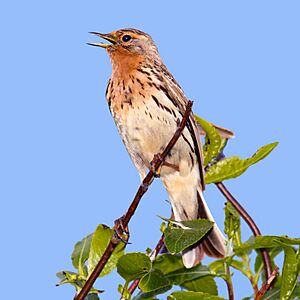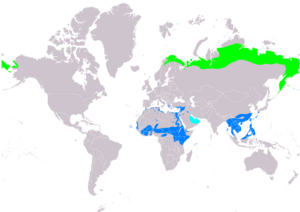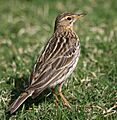Red-throated pipit facts for kids
Quick facts for kids Red-throated pipit |
|
|---|---|
 |
|
| Conservation status | |
| Scientific classification | |
 |
|
| Range of A. cervinus Breeding Passage Non-breeding |
The red-throated pipit (Anthus cervinus) is a small songbird. It lives and raises its young in the very northern parts of Europe, Asia (the Palearctic region), and even a small part of northern Alaska.
This amazing bird travels very far! When winter comes, it flies south to places like Africa, South and East Asia, and the West Coast of the United States. Sometimes, it can even be seen by accident in Western Europe.
Contents
What's in a Name?
The red-throated pipit's scientific name, Anthus cervinus, comes from Latin.
- The first part, Anthus, is an old Latin name for a small bird that lives in grasslands.
- The second part, cervinus, means "stag-coloured." This refers to the reddish-brown colour of a stag (a male deer). It describes the bird's reddish throat and face during breeding season.
How to Spot a Red-throated Pipit
This is a small pipit bird. It's easiest to tell them apart during the breeding season.
- During this time, adult birds have a bright brick-red face and throat. This is how they get their name!
- At other times of the year, they look more plain. They are mostly streaky brown on top. Their undersides are white with black streaks.
- They look a lot like the meadow pipit. In autumn, they also look similar to the tree pipit.
- However, the red-throated pipit has more streaks on its head, back, sides, and chest.
- When it flies, the red-throated pipit has a strong, straight flight. It makes a special psii sound as it flies.
Life and Habits
The red-throated pipit lives in the cold, northern areas of Europe and Asia.
Where They Live
They like open areas for breeding. This includes mountains, wet marshlands, and wide-open tundra.
Nesting and Reproduction
The red-throated pipit builds its nest on the ground. Often, it's hidden next to a clump of grass or on a small mound in a marsh.
- The nest is made from dry grasses and sedges.
- It has a soft lining inside, sometimes made of reindeer hair or soft down feathers.
- The female bird usually lays four to six eggs.
- She sits on the eggs for almost two weeks to keep them warm.
- The young birds are ready to leave the nest about 12 days after they hatch.
What They Eat
Like other pipits, these birds mostly eat insects. They also enjoy eating seeds.
Is the Red-throated Pipit in Danger?
The red-throated pipit lives across a very large area. Scientists believe there are about two million of these birds in the world.
- The IUCN (International Union for Conservation of Nature) says the red-throated pipit is a species of "least concern."
- This means their population is stable. They are not facing any big threats right now.
Gallery




